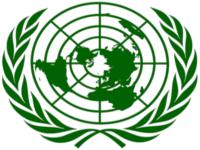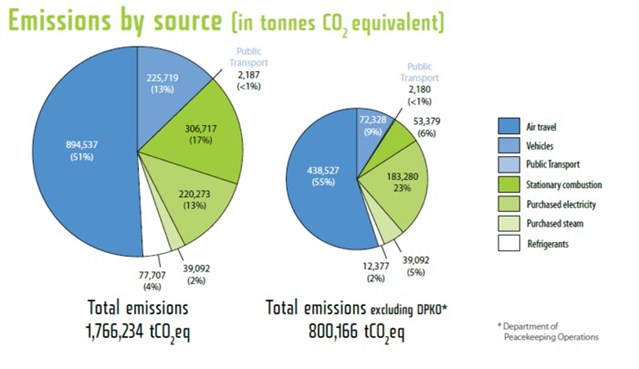Greening the Blue - How the UN is Approaching Carbon Neutrality
 High-flying UN officials are being encouraged to take the train or to make better use of teleconferencing in an effort to reduce greenhouse gas (GHG) emissions from its many operations.
High-flying UN officials are being encouraged to take the train or to make better use of teleconferencing in an effort to reduce greenhouse gas (GHG) emissions from its many operations.The UN released its third annual ‘Moving Towards a Climate Neutral UN’ report last week detailing the sources of its GHG emissions for 2010 and the progress it is making in reducing them.
The report outlines the UN’s 2010 emissions for 54 entities across hundreds of locations. It shows the UN’s total GHG emissions were 1.8 million tonnes of CO₂ equivalent, roughly the same amount of carbon sequestered annually by 383,795 acres of pine or fir forests.
Discounting UN peace keeping operations, total emissions were just over 800,000 tonnes of CO₂ equivalent.
Over 50 percent of the UN’s GHG emissions are from air travel (4.2 tonnes per capita), making this the biggest challenge for the organization in reducing its overall emissions.

In some UN agencies, air travel represents a much greater percentage of overall emissions. Air transportation in fact accounted for 97 percent of the GHG emissions chalked up by the 500 employees of the United Nations Framework Convention on Climate Change, the UN body leading the charge against climate change.
For the 1,200 person United Nations Environment Programme (UNEP), air travel accounted for 94 percent of that agency’s GHG emissions in 2010, slightly below the 95 percent of the 1,500 person Economic Commission for Africa.
Actions being taken across the UN system to cut emissions include encouraging train journeys over air travel, giving bicycles to staff members, installing efficient lighting systems in UN offices or using e-conferencing instead of traveling to meetings.
Cutting transportation-related emissions will be particularly tough because meeting with people across the world is essential to the UN’s work. But efforts are underway to ensure that “think before you travel” becomes a habit not only for UN staff, but also for experts, consultants and conference-goers.
Several UN entities are now procuring high quality carbon offsets, and many others are taking interest in offsetting emissions from UN events and making them climate neutral.
Other efforts to reduce carbon emissions in 2010 included a new “energy neutral” headquarters for the UNEP and UN-HABITAT, which features 6,000 square metres of solar panels, energy-saving lighting and natural ventilation systems.
A newStrategic Plan for Sustainability Managementin the UN System was approved to move UN organizations toward a consistent, systematic and cost-effective approach to managing sustainability.
Proving that every little bit helps, the UN office at Geneva invited hundreds of sheep to graze the grasslands surrounding the Palais des Nations. The sheep cut the grass in an ecologically sustainable manner and provided natural fertilizer for the grass and flowers to grow in spring.
All UN bodies are required to estimate their GHG emissions, undertake efforts to reduce emissions and analyze the cost implications of purchasing carbon offsets. The emissions calculations used in the latest report were developed by the World Resources Institute and the World Business Council for Sustainable Development.
“By championing a climate neutral UN, the various organizations, agencies, programmes and funds are becoming part of a global community developing innovative solutions and sharing lessons learnt on the challenges and opportunities at hand,” said UNEP Executive Director Achim Steiner.
You can return to the main Market News page, or press the Back button on your browser.

